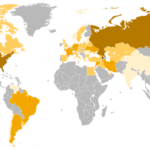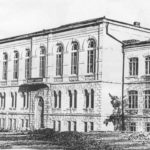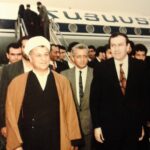WikiLeaks – Armenia No 119
2008-04-10
C O N F I D E N T I A L SECTION 01 OF 02 YEREVAN 000315
SUBJECT: ARMENIA’S PRESDENTIAL INAUGURATION: SERZH STANDS ALONE
Classified By: CDA JOSEPH PENNINGTON, REAONS 1.5(B,D)
——
SUMMARY
——-
¶1. (C) Former Prime Minister Serzh Sargsian was sworn in as Armenia’s third president in a solemn ceremony in Yerevan’s opera house on April 9. Meanwhile, several thousand opposition supporters laid flowers near the French Embassy in honor of those killed in the authorities’ March 1-2 crackdown on post-election demonstrators. In a departure from past inaugurations, the new president, standing alone at the top of the stairs leading out from the opera, reviewed hundreds of Armenian troops as they filed past on adjacent Freedom Square, the site of 10 days of mass protests following the February 19 election. Sargsian sent mixed messages in his inaugural address, pledging to “build an Armenia based on love and tolerance,” while warning of the dangers of “unchecked freedom.”
End summary.
———————————————
INAUGURATION IMAGES — IT’S LONELY AT THE TOP
———————————————
¶2. (C) In a long-anticipated transition of authority, Serzh Sargsian replaced Robert Kocharian as president of Armenia April 9, in a ceremony winessed by most of Armenia’s 131 parliamentarians and hundreds of other Armenian and foreign dignitaries. EUR DAS Matthew Bryza, accompanied by CDA, attended for the United States. Most European countries were represented by their ambassadors accredited to Yerevan. The Georgian Prime Minister was in attendance, as was the Deputy Speaker of the Russian Duma and EU Special Representative for the Caucasus Peter Semneby.
¶3. (C) The ceremony was highly ritualistic, solemn and dignified, to the point that one close embassy contact described it as “mournful.” Once all the guests were seated, projection screens on either side of the stage flashed images of an utterly empty Freedom Square. In fact, all traffic — both vehicle and pedestrian — had been cleared for a three-block area around the opera in the hours preceding the ceremony, leaving the normally-bustling city center eerily vacant. Moments later, a lone black Mercedes pulled up to the entrance, and Sargsian got out — alone — and entered the building as his long, red-carpet walk to the stage was captured on the projection screens. After a series of formalities, including the ceremonial placing of a 7th-century Armenian Bible and the Armenian constitution at the podium, the President-elect recited the oath, apparently from memory, and the transfer of power was complete.
¶4. (C) Seated behind a table on the left side of the stage, the new President sat isolated from all other participants throughout the ceremony, except when he delivered his inaugural address from the podium. When the ceremony was completed, official guests were escorted to an upstairs hall for a reception (which was not optional, as it was made clear that no one could leave the building), while Sargsian exited the opera to stand at the top of the stairs to review hundreds of Armenian soldiers as they filed by in formation across Freedom Square. Guests at the cocktail were riveted by the striking image — once again projected on TV screens around the reception hall — of President Sargsian standing, alone and expressionless, as military marches and the sound of soldiers marching rang out across the square that until March 1 had been occupied by up to 50,000 opposition supporters protesting the flawed vote on February 19. There was not a single civilian onlooker anywhere — a deeply awkward visual for the nationwide television audience.
——————————————— ————
THE ADDRESS — LOVE, TOERANCE, AND MAYBE A LITTLE FREEDOM
——————————————— ————
¶5. (U) The new President’s inaugural address was full of references to the hard-fought presidential campaign and its violent aftermath, including veiled allusions to opposition leader and former President Levon Ter-Petrossian (LTP). The tone of the address was generally conciliatory. Referring to the presidential campaign as “intense, and not without insults,” Sargsian thanked “those who accepted their defeat with dignity, and those who reciprocated the extended hand of cooperation.” He added that “we should not create divisions between various parts of our nation, nor should we disregard each other’s concerns and pain.” “If there is a wall of misunderstanding between us,” Sargsian continued, “I urge you to join us in eliminating that wall.” “We shall build an Armenia where mutual respect, love, and tolerance will prevail.” The President pledged to contribute “all of my strength so that an atmosphere of confidence prevails in our society, and to overcome polarization and confrontation.”
¶6. (U) Sargsian also spoke extensively about the issue of freedom, but here the message was less uplifting. “Unchecked freedom can result in conflict with the public interest and the rights of others,” Sargsian argued, adding that “to prevnet such conflict the state may interfere with the exercise of certain fundamental rights.” “Limitations on fundamental rights, however, cannot be absolute,” he conceded. Referring specifically to the question of freedom of assembly, Sargsian promised to “strike a fair balance between public order on the one hand, and the right to peaceful assembly on the other.” He concluded by pledging to “revisit” the recently-passed law regulating peaceful assembly “to safeguard everyone’s right to peaceful assembly in accordance with European standards.” The new Presdent made clear, however, that any revision “must preclude any public event that is either not peaceful or does not pursue a legitimate aim.”
——-
COMMENT
——- ¶7. (C) To an American observer, inauguration day in Yerevan was notable mostly for the complete absence of contact between the new President and the people he claims to represent. The strict measures taken by police to clear the downtown area of ordinary citizens meant that no Armenians (except the dignitaries who attended the ceremony) were allowed even a glimpse of their new President, except on television. There were no smiles, no handshakes, no waving to a crowd. This impression can be chalked up at least in part to cultural differences — our Armenian staff tell us that extreme solemnity is an expected and valued trait in senior officials, and that American-style gladhanding could be perceived as a lack of gravitas. Neither LTP nor former President Kocharian were especially comfortable with people and their inauguration ceremonies were in many ways similar to what we saw yesterday. Cultural differences aside, however, we cannot help but perceive this as a missed opportunity for Sargsian. Every aspect of the inaugural events — the deliberate physical isolation of the President, his wooden and unsmiling delivery, and his decision to include the military — will only reinforce his public image as cold, distant, weak, and overly reliant on the security services.
¶8. (C) The unprecedented review of military units on Freedom Square will likely be viewed as a direct affront and warning to LTP and his supporters, and risks offending other Armenians who associate the square with the heady days of anti-Soviet protests and the Karabakh movement of the late 1980s. Armenians have long memories, and the sight of boots marching on the square — in direct contradiction to the soaring rhetoric on love and tolerance in Sargsian’s speech — will not be forgotten anytime soon. The new President’s take on freedom, which he apparently views as a threat to be contained rather than an ideal to be pursued, bodes ill for true efforts toward political reconciliation and a healing of the wounds of March 1.
PENNINGTON












